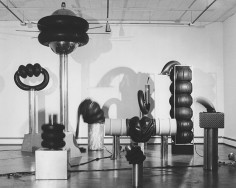DAVID JACOBS
Sound Sculpture
source: davidjacobssculpture
In 1964 David Jacobs became friends with K.C. Li, whose family owned the Wah Chang tungsten refinery in Glen Cove, New York. Li provided Jacobs with ample studio space in the Wah Chang factory, where he was often startled by machinery that rumbled into operation late at night. By 1967 Jacobs had produced Mother, an initially flaccid stack of rubber inner tubes that inflates to wriggling life when a hidden vacuum pump is activated. By combining metal elements and rubber tubing in various configurations, Jacobs produced several additional kinetic sculptures in 1967, each of which is programmed to move and create sound with unique anthropomorphism. Beginning with an exhibition at Hofstra University’s Emily Lowe Gallery, these “Wah Wah” sculptures were typically presented as a group in the late 1960s, performing for audiences like a cacophonous orchestra.
By 1970 the “Wah Wah” sculptures had shed much of their figurative animation as Jacobs became more focused on the bodily apprehension of sound. In these later works, columns of rubber billows are suspended from the ceiling and terminate in long, floor-hugging, metal pipes. When pumped through with air, the sculptures emit an insistent hum and infuse their surroundings with palpable vibrations. Recognized as an innovator in the nascent field of sound art, Jacobs was included in several important group exhibitions during this period, including “Inflatable Sculpture” at the Jewish Museum (NY) in 1969, and “Sound Sculpture” at the Vancouver Art Gallery (BC) in 1973.
.
.
.
.
.
.
.
source: davidjacobssculpture
David Jacobs grew up in central Michigan in the 1930s, where his creativity was nurtured in weekend classes at the Flint Institute of Art. He spent his teenage years in southern California, and eventually earned his bachelor’s and master’s degrees from Los Angeles State College. After joining the faculty of Ohio State University in 1957, Jacobs turned from painting to sculpture and began welding assemblages from found metal objects. On the strength of this early work he forged connections with the New York art world and commenced showing his sculptures in prominent galleries and museums.
In 1962 Jacobs became a professor at Hofstra University and settled in Sea Cliff, New York. From here his work evolved in dynamic dialogue with major movements of the 1960s, including Pop art, Minimalism, and kinetic sculpture. By the late 1960s, Jacobs gained recognition as a pioneer sound artist for his clamorous “Wah Wah” sculptures, which performed for audiences across the country through the 1970s. In subsequent decades he has created numerous aluminum sculptures that examine architectonic, typographic, and calligraphic forms in extended series. Having retired from teaching in 1995, Jacobs continues to live and work on Long Island.


